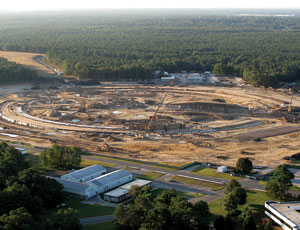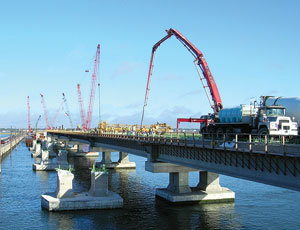With the one-year anniversary of the $787-billion federal stimulus package only a month away, we thought we’d use this opportunity to avert our attention away from the doom and gloom predictions for the near future and highlight some of the region’s best stimulus-funded projects. Our parent publication, Engineering News-Record, recently profiled 22 of the nation’s most newsworthy and noteworthy stimulus projects in four categories: Transportation, Energy, Environment and Buildings. As it turns out, all three states in our region – New York, New Jersey and Connecticut – have active projects that made the cut. Those three projects are featured on the pages that follow. This will be part of an ongoing series we plan to run all year that looks at interesting, innovative and impressive projects – large or small – that are still going strong despite the bleak economic climate.-Ed.

National Synchrotron Light Source II
Jobs Created: Speeded site staffing level to 140 ARRA
Contract Amount: $150 Million

Route 52 Causeway Reconstruction
Phase 2 Jobs Created Total: 500
Current 121 ARRA Contract Amount: $70 Million
Actual Contract Value: $251 Million
New York Upon the 2012 completion of the various segments of what is called the National Synchrotron Light Source II, the scientists will shoot very strong beams of X-ray, ultraviolet and infrared light at all kinds of materials, searching for breakthroughs in medicine and physics. The lab has not moved up the official start date for the experimental beam lines, but the stimulus-speeded parts of the project may help gain critical time for the delicate and complex scientific equipment to be installed and commissioned. The stimulus money also has ramped up the staff on-site to about 140, many of them craft-workers employed by subcontractors doing ground and foundation work.
The basic structure is a ring in plan and is being built in segments. Contractors have started steel erection and are busy placing the project’s 40,000 cu yd of concrete, which is going into foundations, slabs needed for mounting equipment and an above-grade tunnel running through the facility.
Two critical segments along the interior of the ring jumped ahead with the arrival of the stimulus money. One is the injection building, a structure containing a linear accelerator producing high-intensity light. With the stimulus money, the scheduled completion of that structure advanced six months to May 2011. Another structure is the radio-frequencing building. It should wrap up two months sooner, in March 2011.
Federally funded laboratories (Brookha-ven is operated on behalf of the U.S. Dept. of Energy) depend on annual allocations from Congress, and before the stimulus funding, the construction schedule could not run ahead of the lab’s existing funding. The original project schedule had an uneven pace of concrete placement because of these restrictions.
When Marty Fallier, who is leading the project’s conventional construction for the lab, learned in March about the stimulus funding, it allowed him to loosen the reins on the project’s prime contractor, Torcon Inc., Red Bank, N.J., which had started work under its $172-million contract a month before. The changes for parts of the project were “a problem you are happy to have,” says Fallier.
Those changes mean Torcon can place concrete on a pace that is logical for the contractors and lab, says Richard Estrin, a Torcon senior vice president and project executive. Steel fabrication, also initially restricted, now is moving more rapidly and any needed steel will be available. “We told the fabricator to go ahead on the entire contract,” says Estrin.
Lab office buildings, for which contracts have not yet been awarded, also jumped ahead with the stimulus money and can be finished in April 2012, rather than in June 2013, says Fallier. As many as five of these roughly 38,000-sq-ft structures will be built along the ring’s outer edge. Design will start in fiscal 2009 rather than 2010. “The project fit well” with the goals of the stimulus, says Fallier. “We were ready to create local jobs.”
And maybe give the scientists more time to set up their bright lights.
New Jersey New Jersey Department of Transportation recently broke ground on the second phase of a major replacement project on the Route 52 causeway near Atlantic City, improving a key link to the southern Jersey Shore tourist region.
NJDOT spokesman Tim Greeley says the $251 million project has been boosted by $70 million in AARA funds and will create 500 new construction jobs throughout its three-year duration.
The project will replace two existing lift bridges at each end of the causeway with fixed spans, as well as make additional improvements to linking roads. The second phase will also eventually create a new visitor’s center, multi-use sidewalks forbicyclists and pedestrians and several fishing piers.
NJDOT is investing $469 million in ARRA funding in more than 40 road and bridge construction and design projects. The $145 million first phase of the reconstruction project began in October 2006 and included the replacement...

Post a comment to this article
Report Abusive Comment